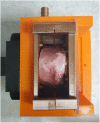A modular surgical simulator for microlaryngoscopy using standard instruments and the carbon dioxide laser
- PMID: 36000063
- PMCID: PMC9392373
- DOI: 10.1002/lio2.854
A modular surgical simulator for microlaryngoscopy using standard instruments and the carbon dioxide laser
Abstract
Objective: Build a microlaryngoscopy surgical simulator for endoscopic laryngeal surgery using standard microsurgical instruments and a CO2 laser.
Study design: Anatomical modeling, CAD design and 3D printed manufacturing.
Subjects and methods: We created a modular design for a microlaryngoscopy simulator in CAD software. Components include plastic and stainless-steel models of a standard operating laryngoscope and a cassette system for mounting porcine or synthetic models of the vocal folds. All simulator parts, including the metallic laryngoscope model, were manufactured using 3D printing technology. Tumors were simulated in porcine tissue models by injecting a soy protein-based tumor phantom. Residents and faculty in the Louisiana State University otolaryngology department evaluated the system. Each participant performed microlaryngoscopy with laser resection on a porcine larynx and cold instrument procedures on synthetic vocal folds. Participants scored the simulator using a 5-point Likert scale.
Results: The microlaryngeal surgical simulator demonstrated in this project is realistic, economical, and easily assembled. We have included 3D printed parts files and detailed assembly instructions that will enable educators interested in surgical simulation to build the device.Participants in the simulator evaluation session felt that the simulator faithfully represented the procedure to resect vocal fold lesions using a CO2 laser. The synthetic model allows the trainee to develop hand-eye coordination while using standard laryngeal instruments.
Conclusions: The simulator described herein will enable surgeons to acquire the surgical skills necessary to perform operative microlaryngoscopy prior to operating on live patients.
Keywords: 3D printing; CO2 laser; microlaryngoscopy; surgical simulation.
© 2022 The Authors. Laryngoscope Investigative Otolaryngology published by Wiley Periodicals LLC on behalf of The Triological Society.
Conflict of interest statement
The author declares there is no potential conflicts of interest.
Figures






References
-
- Moglia A, Vincenzo F, Morelli L, et al. A systematic review of virtual reality simulators for robot‐assisted surgery. Eur Urol. 2016;69(6):1065‐1080. - PubMed
LinkOut - more resources
Full Text Sources
Miscellaneous
